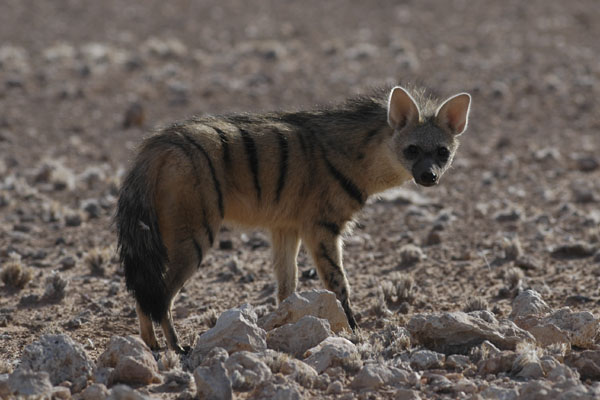Aardwolf
From Wikipedia, the free encyclopedia
[Photo] Aardwolf (Proteles cristatus); Erdwolf, Namib-Nord, Namibia, 2005. Date 08.06.2005. Author Dominik K??uferle (http://de.wikipedia.org/wiki/User:Dkaeuferle). Copyright (C) 2005 Dominik K??uferle
Permission is granted to copy, distribute and/or modify this document under the terms of the GNU Free Documentation License, Version 1.2 or any later version published by the Free Software Foundation; with no Invariant Sections, no Front-Cover Texts, and no Back-Cover Texts. A copy of the license is included in the section entitled "GNU Free Documentation License". |
The aardwolf (Proteles cristatus) is a small insectivorous hyena-like mammal, native to Eastern and Southern Africa. The name means "earth wolf" in Afrikaans. It is also called "maanhaar-jackal" and "protelid". Unlike true hyenas, the aardwolf is a defenseless animal whose diet almost completely consists of termites, other insect larvae and carrion. The natural enemies are deterred by the superficial resemblance to the more aggressive hyena species.
The aardwolf is the only surviving species of the subfamily Protelinae. Two geographically separate subspecies are recognized: Proteles cristatus cristatus of Southern Africa, and Proteles cristatus septentrionalis of Eastern and Northeastern Africa. It is usually placed in the Hyaenidae, though formerly separated in another family (Protelidae).
Physical characteristics
The aardwolf looks most like the Striped Hyena, but is significantly smaller and has a more pointed muzzle, sharper ears used for listening for harvester termites, black vertical stripes on a coat of yellowish fur, and a long, distinct mane down the middle line of the neck and back, which is raised during a confrontation to make the aardwolf's size appear bigger. It is 55???80 cm long, excluding its bushy 20???30 cm tail, stands about 40???50 cm at the shoulder, and weighs between 9 and 14 kg. Its front feet have 5 toes. Its teeth and skull are similar to that of the hyena, although the cheek teeth are specialised for eating insects, and its tongue for licking them up. As the aardwolf ages, it will normally lose some of its teeth, though this has little impact on their feeding habits due to the soft nature of the insects they consume. It has two glands at the rear that secrete a musky fluid for marking territory and communicating with other aardwolves.
Distribution and habitat
The aardwolf lives on open, dry plains and bushland, while avoiding mountainous areas. Due to its specific food requirements, the animal is only found in regions where termites of the family Hodotermitidae occur. Termites of this family depend on dead and withered grass and are most populous in heavily grazed grasslands and savannas, including farmland. For most of the year, aardwolves spend time in shared territories consisting of up to a dozen dens which are occupied for six weeks at a time.
There are two distinct populations: one in Southern Africa, and another in East and Northeast Africa. The species does not occur in the intermediary miombo forests.
Behavior
Aardwolves are shy and nocturnal, sleeping in underground burrows by day. They usually use existing burrows of aardvarks, Old World porcupines or springhares, despite being capable of creating their own. By night, an aardwolf can consume up to 200,000 harvester termites using its sticky, long tongue. They take special care not to destroy the termite mound or consume the entire colony, which ensures that the termites can rebuild and provide a continuous supply of food. They will often memorise and return to nests to save the trouble of finding a new one. They are also known to feed on other insects, larvae, and eggs, and occasionally small mammals and birds. Unlike other hyenas, it does not scavenge or kill larger animals because of its weak jaw and small size.
The aardwolf is primarily solitary (especially with the males), but a mating pair will occupy the same territory with their young. Young aardwolves generally achieve sexual maturity after two years, and the breeding season varies depending on their location, but normally takes place during the autumn or spring. During the breeding season, male aardwolves will search their own territory as well as others' for a female to mate with. This can often result in conflict between two male aardwolves when one has wandered into another's territory. Gestation lasts between 90 and 110 days, producing 1 to 5 cubs (though it is normally between 2 and 3) during the rainy season when termites are active. The first six to eight weeks are spent in the den with the mother. After three months, they begin supervised foraging and by four months are normally independent. However, they will often use the same den as their mother until the next breeding season. They can achieve a lifespan of up to 15 years when in captivity.
Interaction with humans
The aardwolf has taken advantage of the development of agriculture in the continent. They are often considered useful, non-dangerous animals by farmers. However, in some areas the aardwolf is hunted for its fur. Deadly encounters with dogs are another threat.
http://en.wikipedia.org/wiki/Aardwolf
| The text in this page is based on the copyrighted Wikipedia article shown in above URL. It is used under the GNU Free Documentation License. You may redistribute it, verbatim or modified, providing that you comply with the terms of the GFDL. |
|

